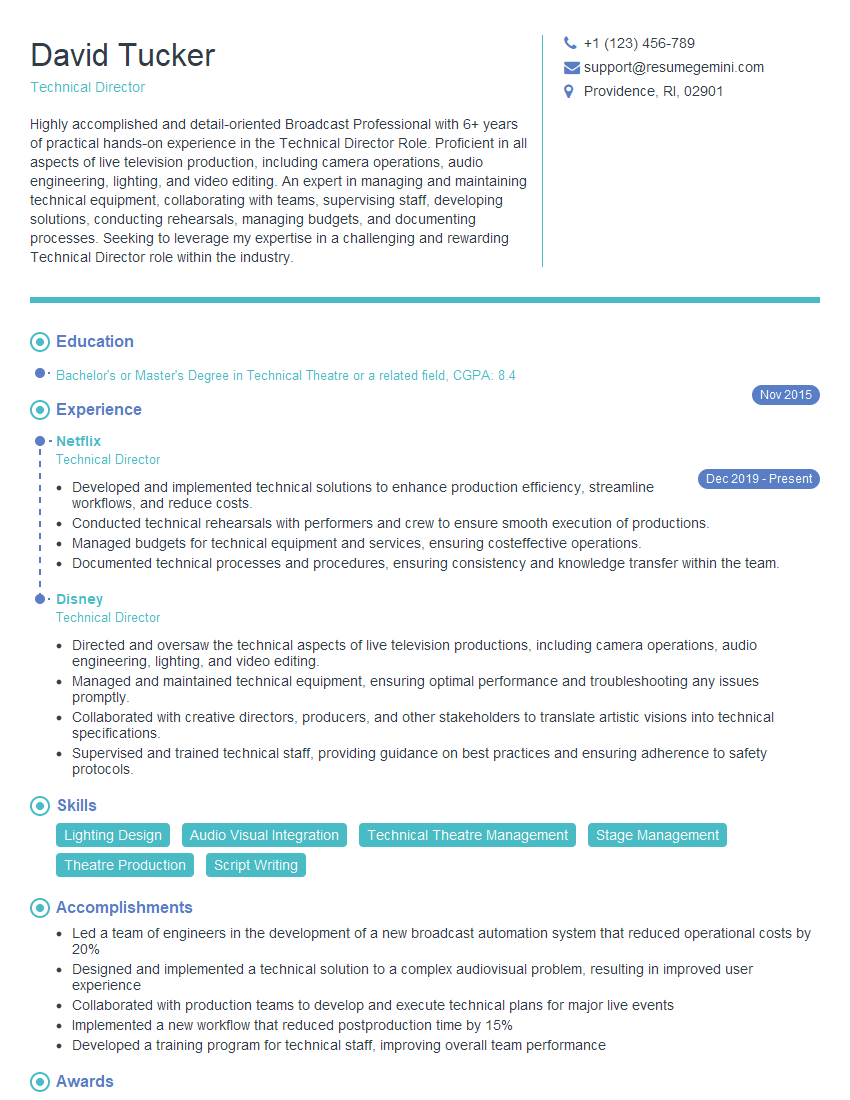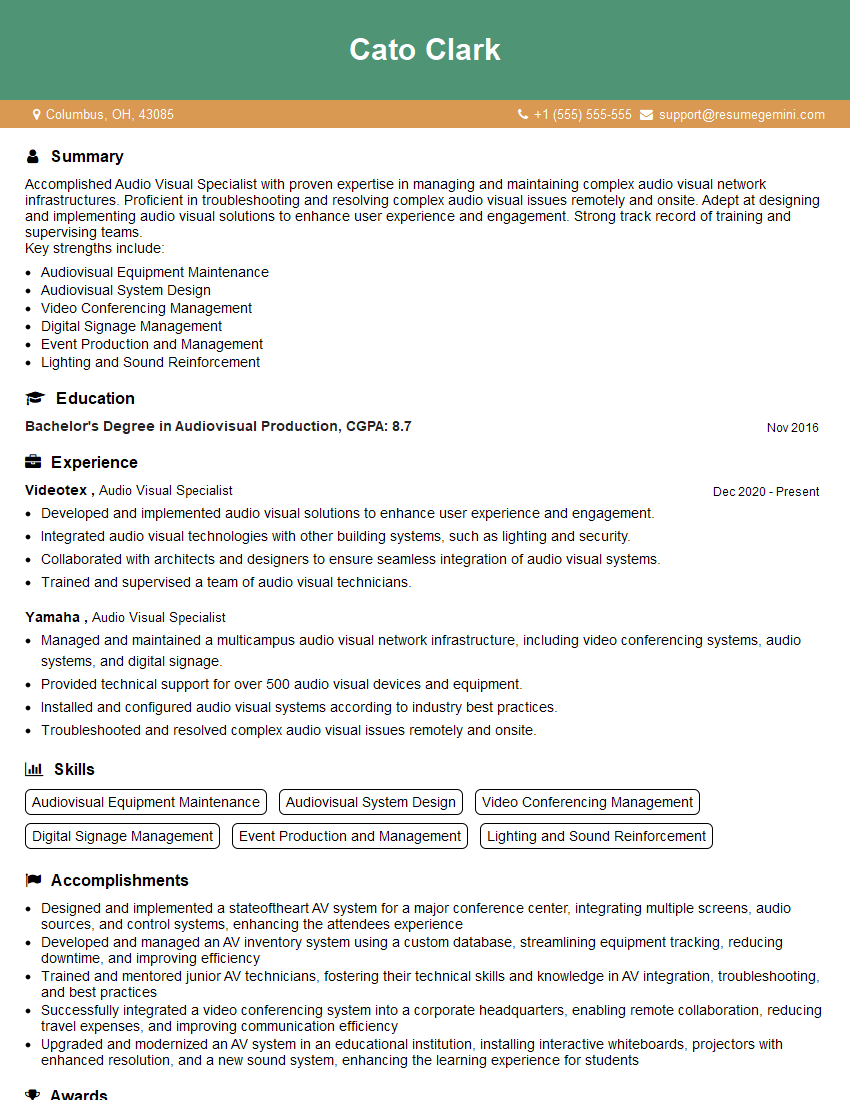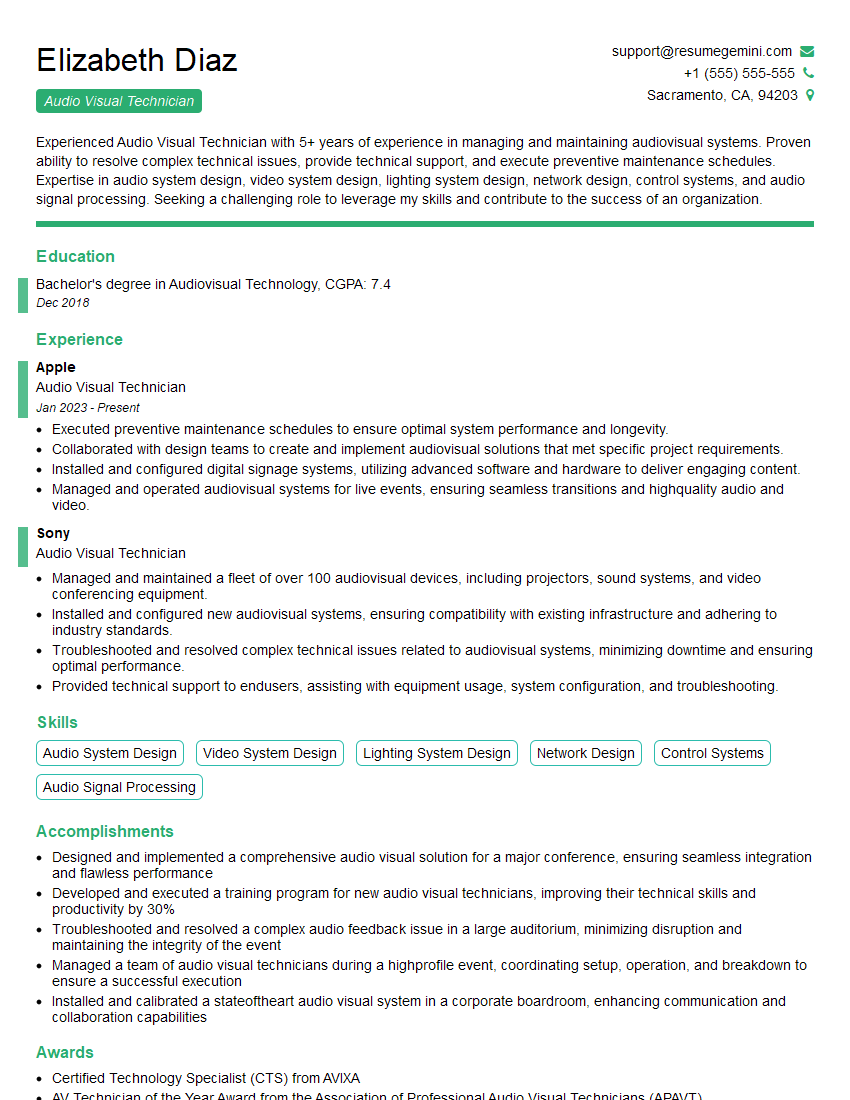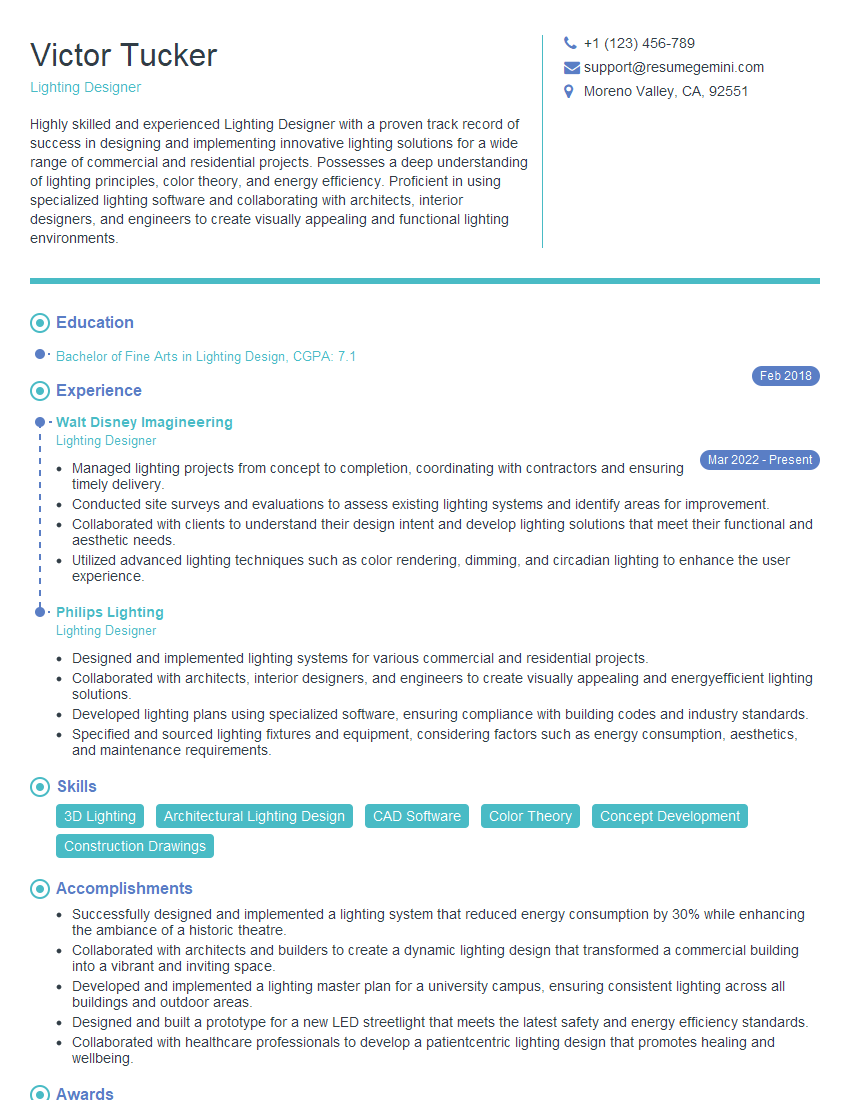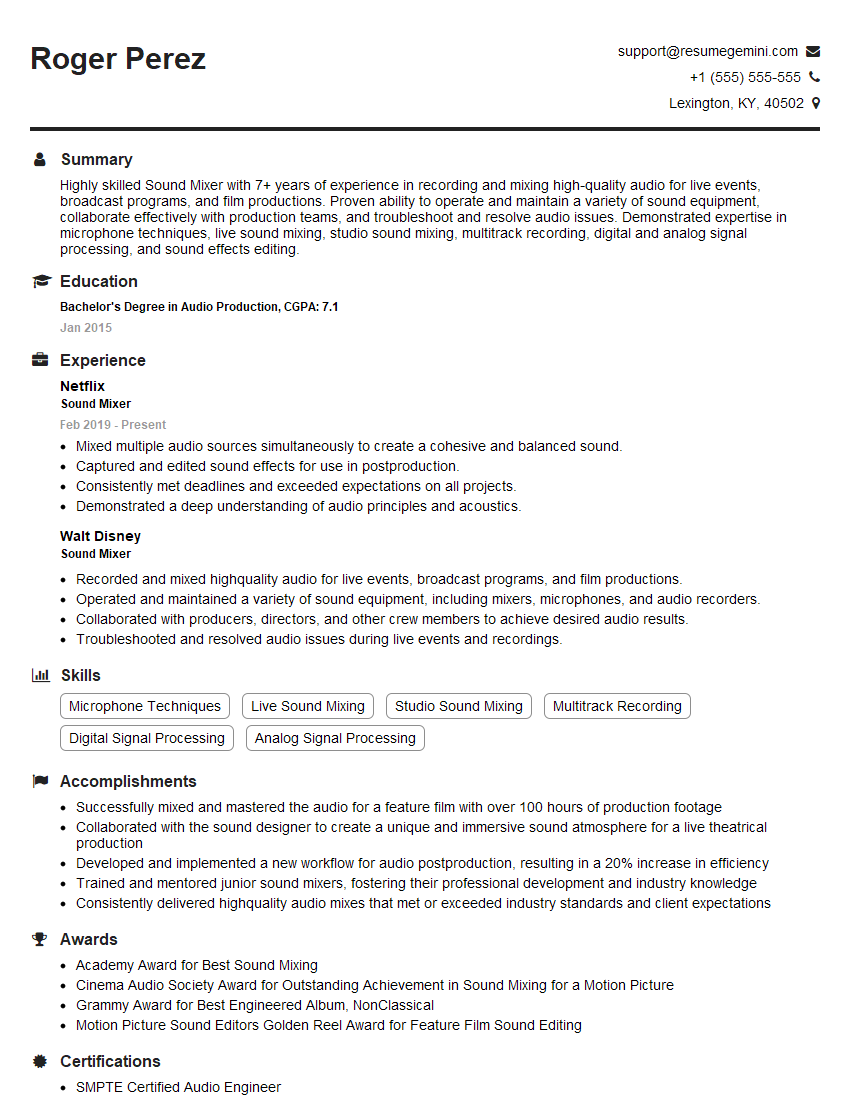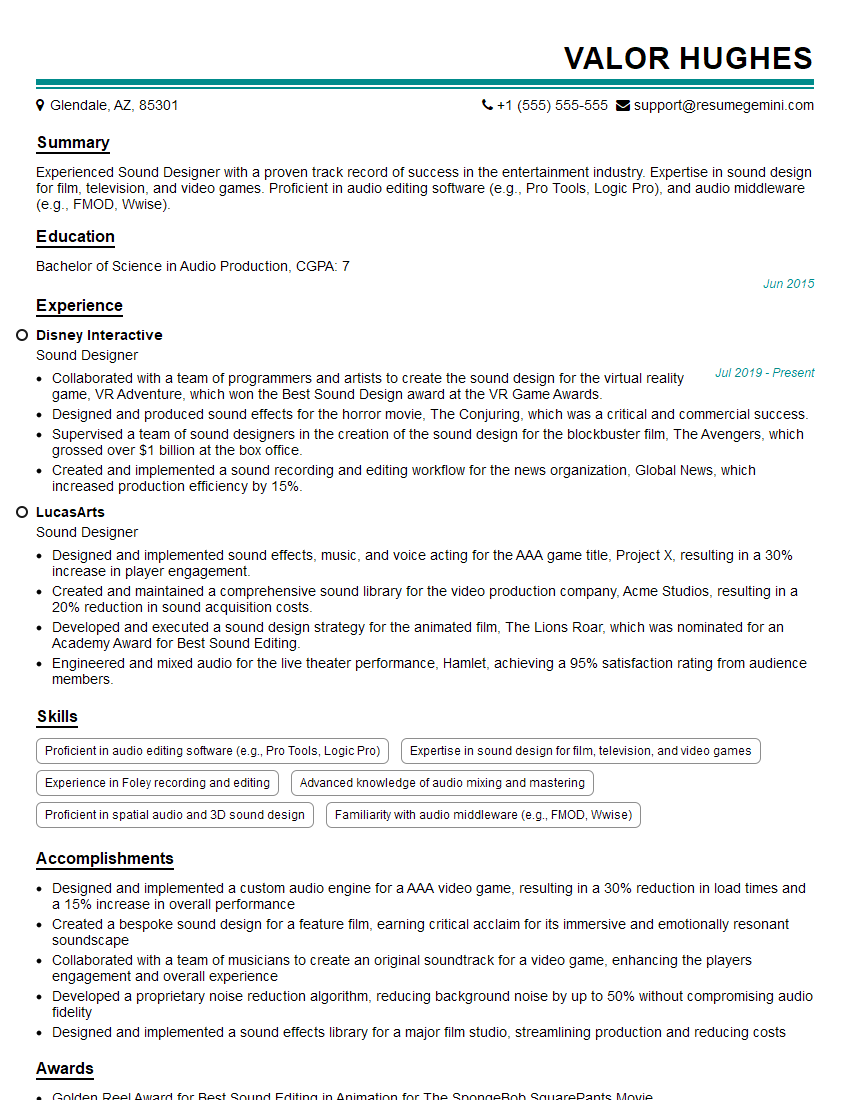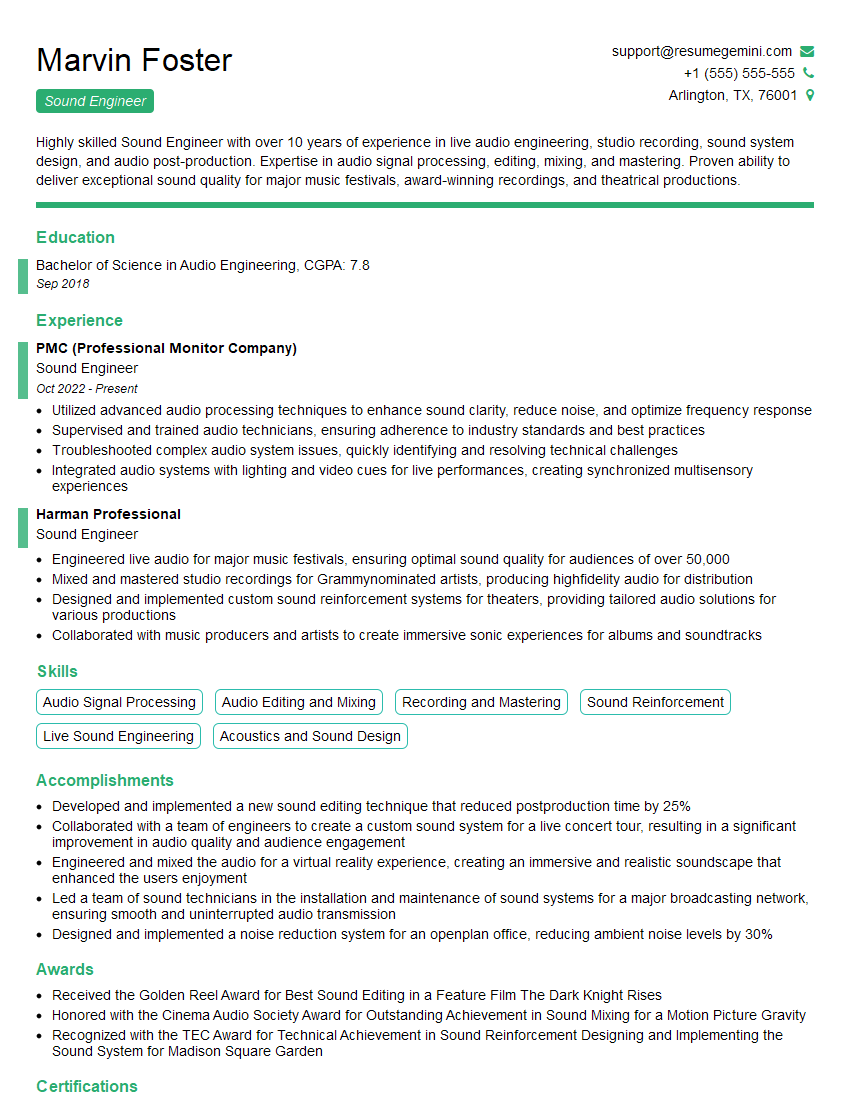Unlock your full potential by mastering the most common Expertise in stage lighting and sound systems interview questions. This blog offers a deep dive into the critical topics, ensuring you’re not only prepared to answer but to excel. With these insights, you’ll approach your interview with clarity and confidence.
Questions Asked in Expertise in stage lighting and sound systems Interview
Q 1. Explain the difference between Fresnel and PAR lights.
Fresnel and PAR lights are both widely used in stage lighting, but they differ significantly in their design, light output, and applications. Think of it like comparing a spotlight to a floodlight.
Fresnel lights use a Fresnel lens – a stepped lens that produces a soft-edged, variable beam. The beam’s size can be adjusted by changing the lens’s focus, allowing for a wide, soft wash or a more concentrated beam. They’re excellent for highlighting actors, creating ambiance, or washing large areas with a smooth, even light. Imagine the warm, gentle glow you often see illuminating a stage actor’s face. That’s often a Fresnel.
PAR (Parabolic Aluminized Reflector) lights use a parabolic reflector to produce a more focused, intense beam. They offer less control over beam spread once the lamp is chosen, and usually provide a harder, more defined edge. PAR cans are frequently used for backlighting, creating dramatic effects, or washing large areas with intense light. Consider the punchy, brightly colored washes you see in concerts; PAR lights are often behind the effect.
In short: Fresnels offer a soft, variable beam ideal for accent lighting, while PARs deliver a sharper, more intense beam suitable for effects and powerful washes.
Q 2. Describe your experience with DMX control protocols.
DMX (Digital Multiplex) is the industry standard for controlling stage lighting and other equipment. My experience spans over ten years, encompassing everything from simple setups to complex, multi-universe systems. I’ve worked with various DMX consoles, including those from ETC, ChamSys, and MA Lighting.
I’m proficient in patching, addressing, and troubleshooting DMX networks. I understand the importance of proper cabling and termination to avoid signal loss and ensure reliable communication. I can confidently create and program complex lighting cues, utilizing various functionalities like chases, effects, and palettes.
For example, I once worked on a large-scale theatrical production where we used a 512-channel DMX network to control over 100 lighting fixtures. My role involved programming and operating the lighting console, coordinating with the lighting designer to execute their vision. We successfully integrated DMX control with other systems, like moving lights, to create dynamic and engaging visuals.
Q 3. How do you troubleshoot a faulty microphone?
Troubleshooting a faulty microphone requires a systematic approach. First, I visually inspect the microphone for any physical damage, such as a broken cable or a damaged diaphragm. Then, I check the connections, ensuring that the XLR cable is securely plugged into both the microphone and the mixer.
Next, I’ll test the microphone on a different channel of the mixer or with a different mixer altogether to rule out mixer issues. If the issue persists, I’ll try a different microphone with the same cable and connector to identify if the problem is with the microphone or the cable itself. A simple continuity test with a multimeter on the cable can be quite helpful.
If the problem still exists, I’ll check the phantom power switch on the mixer, ensuring that it’s activated for condenser mics (if applicable). Battery issues should be investigated as well for wireless microphones. If all else fails, the microphone may need repair or replacement.
A real-world example: During a live performance, a vocalist’s microphone suddenly cut out. Through a quick visual inspection, I discovered a loose XLR connector. A simple re-connection resolved the issue immediately.
Q 4. What are the different types of microphones and their applications?
Microphones are classified into various types based on their transducer technology and polar patterns.
- Dynamic Microphones: These are robust, durable microphones ideal for loud stage performances, needing no external power. They handle high sound pressure levels well. Example: Shure SM58, frequently used for vocals.
- Condenser Microphones: These are more sensitive and require phantom power (48V) from the mixer. They’re often preferred for recording studios or applications requiring capturing subtle nuances. Example: Neumann U 87, known for its detailed sound in studio recordings.
- Ribbon Microphones: These are known for their smooth, warm sound and are particularly well-suited to capturing delicate sounds. They are less durable and require careful handling.
- Wireless Microphones: These microphones transmit the audio signal wirelessly using radio frequencies, offering greater freedom of movement. They come in both dynamic and condenser types.
The choice of microphone depends on the application. For instance, a dynamic microphone is suitable for live vocals due to its durability, while a condenser microphone might be better suited for recording instruments in a quiet studio setting because of its sensitivity.
Q 5. Explain the concept of sound reinforcement.
Sound reinforcement is the process of amplifying and distributing sound to a larger audience than could be reached naturally. It involves using microphones to capture the sound source, a mixer to process and route the sound, amplifiers to increase the sound’s power, and speakers to project the sound to the intended listeners.
Imagine a large concert: the artist’s voice alone wouldn’t reach everyone in the stadium. Sound reinforcement ensures every audience member can hear clearly and evenly. It also involves techniques to manage feedback, control room acoustics and maintain sound quality.
Q 6. How do you handle feedback in a sound system?
Feedback is that high-pitched squeal you get when a microphone picks up the sound from a nearby speaker. This happens when the sound from the speaker is loud enough to be picked up by the microphone, amplified, and sent back to the speaker. It’s like a never-ending cycle.
Handling feedback involves several techniques. Lowering the microphone gain is a simple fix. Adjusting the EQ to reduce frequencies causing feedback is another approach. Careful placement of microphones and speakers is crucial, minimizing the path between speaker and microphone. Often using directional microphones can help, as they are less sensitive to sounds coming from the sides and rear. A well-designed room with proper acoustic treatment can reduce the risk of feedback dramatically.
In a practical setting, I might use a combination of these techniques: I would start by reducing the microphone gain, then adjust the EQ to cut frequencies where the feedback is most prominent. If the problem persists, I’d re-position the microphone and speakers. I would also use a feedback suppressor or a noise gate to manage feedback. This is an iterative process; small adjustments can lead to a big difference in the final output.
Q 7. What is the purpose of a sound mixer?
A sound mixer is the central control hub for audio signals. It’s where all audio sources—microphones, instruments, pre-recorded tracks—are combined, processed, and routed to different outputs like speakers or recording devices.
Think of it as an audio traffic controller. It allows you to adjust the volume (gain) of each input, shape the sound using EQ (equalization), and apply effects like reverb or delay. It also manages the routing of signals to different outputs – for example, sending vocals to one set of speakers and instruments to another. Modern digital mixers even offer advanced features like automation and scene recall, which are helpful for larger-scale productions.
The purpose is to achieve balanced, well-mixed audio, that sounds clear, full, and appropriate for its intended application, whether it’s a live concert, studio recording, or theatre production.
Q 8. Describe your experience with various audio consoles.
My experience with audio consoles spans a wide range of digital and analog systems. I’m proficient in operating consoles from major manufacturers like Yamaha (CL series, QL series), Allen & Heath (dLive, iLive), and Soundcraft (Si series, Vi series). I’ve worked with both smaller consoles for intimate settings and large-format consoles for stadium shows. For example, during a recent outdoor concert, I used a Yamaha CL5 console to manage 48 input channels, meticulously routing and mixing audio for multiple artists and instruments. This involved complex signal processing, including EQ, compression, gating, and reverb, to achieve a clear and balanced mix. On smaller projects, I’ve relied on the intuitive interface of an Allen & Heath iLive-T112, perfectly suited for its efficiency and speed in smaller venues. My expertise extends beyond simple mixing; I understand the intricacies of routing, patching, and integrating various audio sources, ensuring a seamless and professional sound.
Q 9. What are your skills in setting up and troubleshooting lighting grids?
Setting up and troubleshooting lighting grids requires a meticulous approach. My skills encompass every stage, from initial design planning and weight calculations to the safe and efficient rigging and de-rigging of lighting fixtures. I’m experienced with various rigging systems, including chain hoists, motors, and counterweight systems, adhering to strict safety regulations like those outlined in ESTA standards. Troubleshooting involves identifying the root cause of issues, whether a faulty connection, a power surge, or a mechanical malfunction. For example, I once resolved a grid issue where a dimmer pack malfunctioned during a performance. By swiftly identifying the problem (a blown fuse in the dimmer), replacing the fuse and resetting the pack, I ensured minimal disruption to the show. My experience allows for proactive problem-solving, minimizing downtime and maximizing safety.
Q 10. Explain your experience with lighting design software.
I’m highly proficient in several lighting design softwares, including Vectorworks, WYSIWYG, and Capture. These tools allow me to create detailed visual representations of lighting designs before implementation. I can effectively model lighting setups for various venues, accurately simulating light distribution and color mixing. For instance, using WYSIWYG, I designed the lighting scheme for a recent theatre production. The software allowed me to precisely position virtual lights, adjust angles and intensities, and even preview the effect on the actors and set. This process significantly improved efficiency by identifying potential problems and making necessary adjustments before the actual installation. Beyond visualization, I’m adept at utilizing the software’s functionality for generating schedules, creating patch lists, and managing lighting data, streamlining the entire lighting process.
Q 11. Describe your experience with different types of speakers and their frequency responses.
My understanding of different speaker types and their frequency responses is crucial for achieving optimal sound quality. I’m familiar with a wide array of speakers, including full-range, subwoofers, and mid-range speakers, each with their own unique characteristics. Full-range speakers, for example, are typically used for smaller venues, covering a broad frequency range but lacking the power and precision of specialized systems. Conversely, subwoofers excel in reproducing low-frequency sounds, adding depth and impact to the audio experience. I understand how frequency response curves influence the perceived sound, and I choose speaker types and placements based on the specific requirements of the venue and the performance. For instance, in a large stadium, a line array system, comprised of multiple speakers arranged in a vertical line, is often used to provide even sound coverage across a large audience. Understanding the limitations of each speaker type – such as a tweeter’s susceptibility to distortion at high volumes – allows me to make informed decisions, ensuring a superior audio experience.
Q 12. How do you ensure even sound distribution in a large venue?
Ensuring even sound distribution in a large venue requires careful planning and execution. This involves a combination of speaker placement, system design, and signal processing. Factors to consider include the venue’s acoustics, audience size, and the desired sound quality. For large spaces, a line array system is often employed. These systems, composed of multiple speakers arranged in a vertical line, are designed to project sound evenly over a large distance. Careful consideration of time alignment and equalization is crucial; this minimizes phase cancellations and ensures consistent sound across the entire listening area. In addition to the main system, strategically placed fill speakers may be needed to cover areas where the main system’s coverage is weaker. Room EQ software and real-time analyzers help fine-tune the sound, compensating for acoustical anomalies within the venue.
Q 13. How do you manage the power distribution in a lighting system?
Power distribution in a lighting system is critical for safety and functionality. I plan and implement power distribution systems based on the lighting load, ensuring adequate capacity and circuit protection. This involves careful calculations to determine the appropriate amperage and voltage requirements for each circuit, taking into account the power draw of all lighting fixtures. I use properly rated cables, connectors, and distribution panels. Overloading circuits can lead to overheating, which poses significant safety risks and can damage equipment. Using dimmer packs, which control the voltage to individual fixtures, allows for precise lighting control and efficient power usage. I always ensure that the entire power distribution system is grounded properly, mitigating the risks of electrical shocks. Safety measures are paramount, involving regular checks and maintenance to ensure compliance with industry standards.
Q 14. What safety measures do you follow when working with stage lighting and sound equipment?
Safety is my utmost priority when working with stage lighting and sound equipment. I meticulously follow all relevant safety regulations, including those from organizations like ESTA. This includes regular inspection of all equipment for any signs of damage or wear, ensuring all cabling is properly secured and protected, and all connections are made correctly. I always use appropriate personal protective equipment (PPE), such as safety glasses and gloves, when handling equipment. Lockout/tagout procedures are followed during maintenance and repairs to prevent accidental energization. I ensure all equipment is properly grounded to prevent electrical shocks. In addition to physical safety, I’m aware of the potential hazards of high-intensity lighting and ensure that appropriate precautions are taken to avoid injury, particularly regarding eye safety. I also conduct thorough risk assessments before each event, identifying and mitigating any potential hazards.
Q 15. Explain your experience with signal processing and effects.
Signal processing and effects are fundamental to shaping the sound and light in a performance. My experience encompasses a wide range of techniques, from basic equalization (EQ) and compression to more advanced effects like reverb, delay, and modulation. In lighting, this translates to using dimmer curves to create smooth fades or employing color correction to achieve specific moods. For sound, consider how a vocalist’s microphone signal might be processed. We might use a compressor to even out volume fluctuations, a gate to reduce background noise, and a reverb to add a sense of spaciousness. I’m proficient in using digital audio workstations (DAWs) like Ableton Live and Pro Tools, as well as lighting consoles such as ETC Ion and MA Lighting grandMA2, to manipulate and creatively apply these effects.
For example, during a recent musical theatre production, we used a combination of delay and reverb to create a sense of depth and space for the vocal harmonies. The delay was subtly applied to create a shimmering effect, and the reverb was carefully tuned to avoid sounding muddy or unnatural. We also employed dynamic EQ to adjust the vocal frequencies in real-time, ensuring clarity throughout the performance, even with fluctuations in vocal volume.
I also have experience with more specialized effects such as pitch shifting and harmonizers for sound design and creating unique sonic textures for special effects. In lighting, this could be using moving lights and sophisticated software to program complex, dynamic chases, color changes, and effects that follow the rhythm of the music or complement the action on stage.
Career Expert Tips:
- Ace those interviews! Prepare effectively by reviewing the Top 50 Most Common Interview Questions on ResumeGemini.
- Navigate your job search with confidence! Explore a wide range of Career Tips on ResumeGemini. Learn about common challenges and recommendations to overcome them.
- Craft the perfect resume! Master the Art of Resume Writing with ResumeGemini’s guide. Showcase your unique qualifications and achievements effectively.
- Don’t miss out on holiday savings! Build your dream resume with ResumeGemini’s ATS optimized templates.
Q 16. Describe your experience with acoustic treatment and room optimization.
Acoustic treatment and room optimization are crucial for achieving clear and balanced sound. My experience involves assessing existing spaces, identifying acoustic issues (like reflections, echoes, and reverberation), and implementing solutions to improve sound quality. This might involve using absorption materials like acoustic panels and bass traps to dampen unwanted sound reflections, or diffusion elements to scatter sound waves and prevent the build-up of standing waves.
For instance, in a recent project, we had a theatre with excessive reverberation. After analyzing the room’s acoustics, we strategically placed acoustic panels on the walls and ceiling to absorb the excess reflections, particularly in the mid and high-frequency ranges. We also implemented bass traps in the corners to absorb low-frequency energy, resulting in a much clearer and more controlled sound. For smaller spaces, strategic furniture placement can also be helpful.
Room optimization is not just about treating sound; it also involves carefully considering speaker placement, subwoofer positioning, and listener positioning to ensure even sound distribution and minimize frequency imbalances. This process involves utilizing professional sound measurement equipment, such as sound level meters and Real-Time Analyzers (RTAs) to take measurements and refine our placement strategy.
Q 17. How do you work effectively as part of a production team?
Effective teamwork is paramount in live production. I thrive in collaborative environments, valuing open communication and mutual respect. I believe in contributing my expertise while actively listening to and incorporating the input of others. I’m adept at coordinating with lighting designers, sound engineers, stage managers, and other crew members to achieve a unified vision.
My approach involves clear and proactive communication. I make sure to thoroughly brief my team on my work process, timelines, and any potential challenges. I also actively solicit their feedback, understanding that different perspectives enrich the creative process and often unearth critical oversights that might otherwise have been missed. During a recent concert, I coordinated with the lighting designer to synchronize the lighting cues with the musical sections. We used a shared network to ensure seamless communication and data transfer.
Furthermore, I understand the importance of adaptability and problem-solving within a team. I approach each challenge as an opportunity for collaboration and creative problem-solving, ensuring everyone feels valued and that we can find solutions together.
Q 18. Explain your process for creating a lighting plot.
Creating a lighting plot is a meticulous process that begins with a thorough understanding of the production’s needs. This includes reviewing the script or performance plan, meeting with the director to discuss their vision, and considering the stage design. I then use specialized lighting design software (like Vectorworks Spotlight or WYSIWYG) to create a visual representation of the lighting setup, including the placement of instruments, their angles, and the types of fixtures being used.
The process generally involves several key steps: 1. Initial Concept: Defining the overall lighting style and mood for each scene. 2. Fixture Selection: Choosing appropriate lighting instruments (e.g., LED washes, spotlights, moving lights) based on the requirements of the production. 3. Positioning and Aiming: Determining the optimal placement and aiming angles of each fixture to achieve the desired lighting effects. 4. Patching and Addressing: Assigning each fixture a unique address in the lighting console. 5. Cueing and Programming: Creating the actual lighting cues (sequences of lighting changes) using a lighting console.
For instance, in designing a lighting plot for a Shakespearean play, I would focus on creating a naturalistic atmosphere, using warm-toned lighting to represent daylight and cooler tones for night scenes. The selection of fixtures would prioritize versatility, allowing me to create a wide range of moods and effects. I would pay close attention to the actor’s positions on stage to ensure adequate illumination, avoiding harsh shadows or unwanted highlights.
Q 19. How do you balance artistic expression with technical requirements in stage lighting?
Balancing artistic expression with technical requirements is a crucial skill for any stage lighting professional. Artistic expression involves translating the director’s vision into a compelling visual experience, while technical requirements focus on ensuring that the lighting system operates safely, reliably, and efficiently. This requires a delicate balance – artistic vision shouldn’t compromise safety, and technical limitations shouldn’t stifle creativity.
I address this by first understanding the director’s artistic vision thoroughly and then determining the technical feasibility of realizing that vision. This frequently entails proposing creative solutions that address both the artistic intent and the technical limitations, perhaps by suggesting alternative lighting techniques or adjusting the lighting design to accommodate the available equipment. For example, if a director wants a specific color, but the existing fixtures can’t accurately reproduce that color, I would explore using color mixing techniques or suggesting the acquisition of specific gel filters.
Open communication with the director and the technical team is key. This collaborative approach allows for the identification and resolution of conflicts early on, preventing potential problems later in the production process.
Q 20. How do you maintain and repair stage lighting and sound equipment?
Maintaining and repairing stage lighting and sound equipment is essential for ensuring smooth and reliable performances. My experience includes regular preventative maintenance checks, troubleshooting malfunctions, and performing repairs as needed. This involves understanding the operational principles of various lighting and sound equipment and possessing the skills to diagnose and fix common issues.
Preventative maintenance includes tasks like regularly cleaning fixtures, checking connections, and ensuring that the equipment is operating within its specified parameters. This greatly reduces the risk of equipment failure during a performance. When malfunctions occur, I follow a systematic troubleshooting process, starting with simple checks (like loose connections or blown fuses) and progressively moving towards more complex diagnostics. I’m proficient in using test equipment such as multimeters to identify issues with wiring or components.
I also have experience with replacing damaged parts, repairing electronics, and working with specialized tools and equipment required for maintaining both sound and lighting systems. I stay up-to-date on the latest equipment and technologies to ensure efficient and effective maintenance.
Q 21. What is your experience with different types of lighting instruments (LED, Tungsten, etc.)?
My experience encompasses a broad range of lighting instruments, including LED, Tungsten, and other specialized fixtures. Each type offers unique characteristics and advantages. Tungsten lights, while increasingly less common due to heat and energy consumption, are known for their warm and natural color rendering. They offer excellent color saturation, although controlling their intensity can be challenging.
LED lighting instruments are now dominant, offering energy efficiency, long lifespan, and precise color control. LEDs are available in a vast array of color temperatures and can be easily dimmed, making them versatile for many applications. Moreover, they can be fitted with various lenses, allowing for greater control over the beam’s shape and spread. I’m experienced in working with both conventional LED fixtures and the sophisticated moving lights often used in contemporary stage productions. Moving lights offer unparalleled versatility, allowing for dynamic and complex lighting effects during performances. Other specialized fixtures, such as ellipsoidal spotlights (for sharp beams) and fresnels (for soft washes), are also part of my skillset.
My knowledge extends beyond just the operation of these instruments; I also understand their limitations and how best to utilize them in conjunction with other lighting instruments. This is critical for creating a balanced and visually stunning light show.
Q 22. What are your experience with wireless microphone systems?
Wireless microphone systems are integral to modern stage productions, offering freedom of movement for performers. My experience encompasses a wide range of systems, from basic UHF systems to more sophisticated digital wireless solutions with features like frequency hopping and AES encryption. I’m proficient in selecting the appropriate system based on factors such as the venue size, potential interference sources (like Wi-Fi routers or other wireless devices), and the number of microphones required. This includes setting up and testing the system to ensure optimal signal strength and minimizing dropouts. I’m also experienced with troubleshooting common problems, such as interference, low battery levels, and microphone gain issues. For instance, during a recent outdoor concert, we experienced significant interference from nearby cellular towers. By carefully selecting frequencies and using directional antennas, we were able to maintain clear audio throughout the performance.
I understand the importance of proper antenna placement and frequency coordination to avoid interference. My experience also includes working with various microphone types, including handheld, lavalier, and headset mics, understanding their unique characteristics and applications. For example, choosing a cardioid condenser mic for a vocalist versus a dynamic mic for a loud instrument requires careful consideration.
Q 23. How do you use EQ to improve sound quality?
EQ, or equalization, is a crucial tool for shaping the frequency balance of audio signals. It allows us to boost or cut specific frequency ranges to improve clarity, reduce muddiness, and enhance the overall sound quality. My approach to EQ is always to listen critically and make subtle adjustments, focusing on specific problem frequencies rather than drastic changes. Imagine a recording with a muddy bass; I might use a parametric EQ to cut frequencies around 250 Hz, where much of the mud resides. This process requires careful attention to detail and an understanding of how different frequencies contribute to the overall tonal balance. Conversely, boosting a particular frequency range can highlight an instrument or vocal.
For instance, a vocalist’s presence can be enhanced by boosting around 5-8kHz, while cutting around 2-4kHz can reduce harshness. I often use graphic EQs for broad adjustments and parametric EQs for more precise control over specific frequencies. The goal is to create a balanced and natural-sounding mix, where each instrument and vocal can be heard clearly without masking or clashing with others. I also consider the acoustic properties of the venue when applying EQ, compensating for any inherent room resonances or imbalances.
Q 24. Explain your understanding of different audio file formats.
Audio file formats vary considerably in their characteristics, primarily in terms of compression and sample rate. Understanding these differences is essential for selecting the correct format for different applications. Lossless formats, such as WAV and AIFF, maintain the original audio quality without any data loss. These are ideal for archiving or situations where the highest fidelity is required, such as mastering. However, they result in larger file sizes.
Conversely, lossy formats, such as MP3 and AAC, compress the audio data by discarding some information that is deemed less audible. This leads to smaller file sizes but inevitably involves some reduction in audio quality. MP3 is still common for streaming and online distribution, offering a reasonable balance between size and quality. AAC, typically used with Apple devices, offers superior quality to MP3 at comparable bitrates. Then there are uncompressed formats such as PCM, which are crucial for professional studio work. Choosing the appropriate format depends heavily on the intended use of the audio. A live recording intended for broadcast might use a lossy format to save space and bandwidth, while studio recordings for mastering would need lossless formats.
Q 25. Describe your experience with various audio editing software.
I’m proficient in several audio editing software packages, including Pro Tools, Logic Pro X, Ableton Live, and Audacity. Pro Tools is my primary DAW (Digital Audio Workstation) for larger projects, offering comprehensive features for recording, editing, mixing, and mastering. Logic Pro X is excellent for both composing and mixing, renowned for its intuitive interface and powerful virtual instruments. Ableton Live’s strengths lie in its loop-based workflow, making it well-suited for electronic music production and live performance. Audacity is a free and open-source option, useful for basic editing tasks.
My experience goes beyond simply using these programs; I understand their underlying signal processing and the implications of various effects and tools. This allows me to make informed decisions about the optimal workflow for a project and choose the right tools to achieve the desired results. For example, I might use Pro Tools’ powerful plugin ecosystem for mixing a complex orchestral recording, while Ableton Live might be suitable for quickly editing and arranging a live drum track.
Q 26. How do you handle unexpected technical issues during a live performance?
Handling unexpected technical issues during a live performance requires quick thinking, problem-solving skills, and a calm demeanor. My approach involves a combination of preparation, troubleshooting, and contingency planning. Before any show, I always conduct thorough pre-show checks of all equipment and ensure backups are available. For instance, we always have spare microphones, cables, and even backup audio interfaces.
If an issue arises during a performance, my first step is to quickly identify the problem. This often involves carefully listening to the audio and visually inspecting the equipment. Once the source of the problem is identified, I work swiftly to implement a solution. This might involve switching to a backup microphone, adjusting settings, or even temporarily silencing a problematic channel to maintain the flow of the performance. Effective communication with the stage manager and performers is crucial to ensure everyone is aware of the situation and can adjust accordingly. Documentation of issues and solutions after the show is essential for improving processes in the future.
Q 27. What strategies do you use for time management and organization during a production?
Time management and organization are critical for successful productions. My strategy involves meticulous planning and the use of scheduling tools. I typically begin by creating a detailed timeline of the production, outlining all tasks and their dependencies. This helps to establish realistic deadlines and identify potential bottlenecks. I break down larger tasks into smaller, more manageable units to facilitate progress and ensure that the various phases of the project align effectively.
Communication and collaboration are equally vital. Regular meetings with the production team ensure that everyone is aware of their responsibilities and that potential issues are identified and addressed early on. I also utilize project management software to track progress, assign tasks, and maintain communication among team members. This helps to ensure that tasks are completed on time and within budget, minimizing stress and maximizing efficiency.
Q 28. Describe a challenging project you worked on and how you overcame the obstacles.
One challenging project involved designing the sound system for a large outdoor festival in a very windy location. The wind caused significant problems with microphone feedback and inconsistent sound levels. The initial plan was compromised due to the unpredictable weather. Overcoming this required a multi-pronged approach. First, we used highly directional microphones to minimize the pickup of ambient noise and wind. Second, we implemented sophisticated feedback suppression systems to help manage the microphone feedback issue. This involved carefully placing strategically positioned microphones and utilizing specialized signal processing techniques. Finally, we created multiple sound zones with individual control systems to balance sound levels across different areas of the festival, compensating for wind-induced variations in acoustic properties.
The solution was a blend of technical expertise and practical problem-solving. We adapted our initial plans to accommodate the unpredictable environment and collaborated closely with the stage crew to implement our solutions effectively. This project highlighted the importance of adaptability and creative problem-solving when dealing with unforeseen challenges in live sound reinforcement.
Key Topics to Learn for Expertise in Stage Lighting and Sound Systems Interview
- Lighting Design Principles: Understanding color theory, light intensity, and the different types of lighting fixtures (LED, incandescent, moving lights) and their applications in various performance settings.
- Sound System Design and Operation: Knowledge of microphones, speakers, mixers, amplifiers, and signal processing. Practical experience with sound system setup, troubleshooting, and equalization (EQ) techniques for optimal sound quality.
- Control Systems and Programming: Familiarity with lighting and sound consoles, including programming techniques, cueing, and show control software. Experience with different control protocols (e.g., DMX, MIDI).
- Health and Safety Regulations: Understanding and adhering to safety protocols related to electrical equipment, rigging, and noise levels. Knowledge of relevant industry standards and best practices.
- Audio Visual Integration: Experience integrating lighting and sound systems with other AV technologies, such as video projection and screen management.
- Troubleshooting and Problem-Solving: Ability to diagnose and resolve technical issues with lighting and sound equipment quickly and efficiently. Practical experience in identifying and rectifying faults under pressure.
- Project Management and Collaboration: Experience working effectively within a team, managing projects, and meeting deadlines. Understanding client needs and communication skills to deliver high-quality results.
Next Steps
Mastering expertise in stage lighting and sound systems opens doors to exciting career opportunities in theatre, live events, concerts, and corporate settings. A strong understanding of these technical skills, coupled with excellent communication and teamwork, significantly enhances your job prospects. Creating an ATS-friendly resume is crucial for getting your application noticed by potential employers. ResumeGemini is a trusted resource to help you build a professional and impactful resume that highlights your skills and experience effectively. Examples of resumes tailored to expertise in stage lighting and sound systems are available to guide you through the process. Invest time in crafting a compelling resume – it’s your first impression!
Explore more articles
Users Rating of Our Blogs
Share Your Experience
We value your feedback! Please rate our content and share your thoughts (optional).
What Readers Say About Our Blog
Live Rent Free!
https://bit.ly/LiveRentFREE
Interesting Article, I liked the depth of knowledge you’ve shared.
Helpful, thanks for sharing.
Hi, I represent a social media marketing agency and liked your blog
Hi, I represent an SEO company that specialises in getting you AI citations and higher rankings on Google. I’d like to offer you a 100% free SEO audit for your website. Would you be interested?
